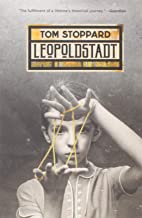Leopoldstadt by Tom Stoppard 2020
I avoid reading Holocaust books because I find that they so sadden and depress me that I’m disoriented and dysfunctional for days, but I made an exception for Stoppard’s recent play after reading several reviews of a new biography by Hermione Lee about him. Stoppard, who achieved fame at a young age with his Tony winning Rosencrantz and Guildenstern has remained productive and successful for 50 years. The child of non-observant Czech Jews, his family escaped the Nazis fleeing first to Singapore where is father died, then India where his mother married an Englishman, and then finally to England itself. This play is his first work to deal with the Holocaust and perhaps his final work at the age of 83. The play won an Olivier Award for the Best New Play in 2020.
The play unfolds over a 56 year history in a single apartment in Vienna. The characters, numbering 29 in all, are members of the Merz family whose matriarch, Grandma Emilia oversees the families of her son (a Christian by choice) and his wife, her daughter and her husband, and the siblings of the various husbands and wives. Before starting the book, I made a family tree showing how all of the 29 were related, unaware that I was mirroring the final scene in the play. In that scene which takes place in 1955, three cousins have returned to the Merz apartment, and 64 year old Freudian analyst from NYC, Rosa, gives the 24 year old Leo a paper on which she has drawn the family tree. These final moments of the play involve Leo (now Leonard Chamberlain after Rosa’s sister married a British journalist and was able to escape Vienna, raising her son as an Englishman) intoning the names of his relatives as he points to each of them on the family tree while Rosa gives the date and site of their deaths—murdered at Auschwitz, Steinhof, Dachau are intoned over and over again while those who escaped the camps only did so to succumb to depression and die by suicide. Of the large and comfortable Merz family who we first meet in 1899, only Grandma Emilia died of natural causes.
The play struck all the notes that have made me a Holocaust-literature avoider as this cast of characters moves from their lives as honored and distinguished professors, doctors, and leaders of business in an anti-Semitic Vienna at the turn of the century to Jews hated and hounded by neighbors and ultimately murdered by the Austrian/German Nazis. The surviving three cousins are left to keep memory alive, but the overwhelming feeling at the play’s end is one of sadness and fear of the next wave of the anti-Semitic hatred that seems to be a constant in history.
The title, Leopoldstat, refers to the Vienna ghetto where Jews were confined and wore yellow stars before Emperor Franz-Josef of the Austro-Hungarian Empire welcomed Jews to become citizens of the Empire with full rights after 1782. By the 1920’s, there were 200,000 Jews in Austria, 10% of the population. After the Anschluss and WWII, today’s Jewish population in Austria is around 7000.
Assimilation and separateness, achievement and a precarious existence, the ‘second death’ of individuals whose photos remain but unknown in photo albums, the classification of Jews as Jews by others—it’s all there, even Klimt’s portrait of Grandma Emilia’s gentile daughter-in-law, stolen by the Nazis and reclaimed by the Freudian analysis from New York.
I found the play to be overwhelming but important to have read.



